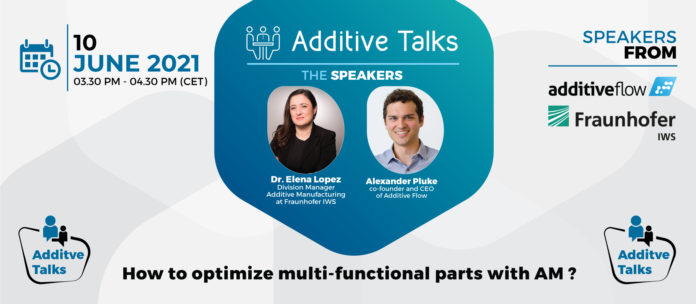Following an insightful panel on the implications of Additive Manufacturing for the Energy industry, the next Additive Talks session will discuss the optimization of multi-functional parts with AM. It is set to take place on June 10th, from 03.30 pm to 04.30 pm CET and will gather representatives from Fraunhofer Institute for Material and Beam Technology (IWS), and Additive Flow.
A closer look at the speakers
The panel will feature Dr. Elena Lopez, Alexander Pluke who work respectively for Fraunhofer IWS and Additive Flow.
Dr. Elena Lopez studied chemical engineering at the Universidad de Valladolid in Spain and Friedrich-Alexander-Universität Erlangen-Nürnberg in Germany. Following her PhD thesis on plasmachemical etching of silicon solar wafers and an experience with CVD technologies, she moved to Additive Manufacturing technologies in 2014. She is currently Head of Department for Additive Manufacturing at Fraunhofer IWS and is leading a big AM consortium named Agent-3D with more than 100 companies involved. In the AM industry, Lopez has built up extensive experience in multi-materials and ceramics, which makes her an ideal speaker to discuss the scope of this topic. If you are not familiar with Fraunhofer IWS, please note that the research institute develops complex system solutions in materials and laser technology. With a key focus on transferring research results directly into industrial applications, the institute’s research encompasses several sectors including aerospace, energy and environmental technology, automotive, medical and mechanical engineering, toolmaking, electrical engineering and microelectronics, photonics and optics sectors.
Alexander Pluke is the co-founder and CEO of Additive Flow, a software company that debuted on the additive manufacturing market with FormFlow; a multi-functional software that can apply multiple user-defined parameters for simultaneous geometry, process parameter and material optimisation. The end of last year saw an upgraded version of the software that now integrates a multi-property optimisation feature. The feature is quite timely as producers are increasingly looking to produce multi-functional parts that would integrate varying properties based on local engineering requirements. Pluke and his team is up to something very interesting, for this panel and for any industry that is looking to achieve multi-functional parts.
So, how to optimize multi-functional parts with Additive Manufacturing?
Additively manufactured components, although extensively customizable, are often limited in functionality. Multi-functionality, by definition, requires the integration of active sub-components in order to deliver additional functional capabilities, such as electronic, electro-mechanical, optical, electromagnetic, chemical and thermal. Here is the thing, the production of such parts does not happen every day because the manufacturing process raises several questions at the design, materials and fabrication levels, but also on the effective integration of such parts in a structure. This panel aims to discuss these questions and shed light on the do’s and don’ts manufacturers should keep in mind at each stage of the manufacturing process.




